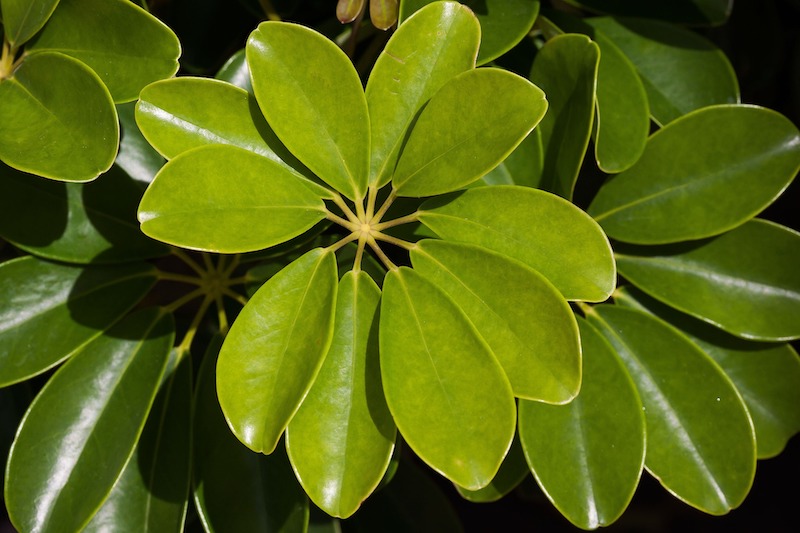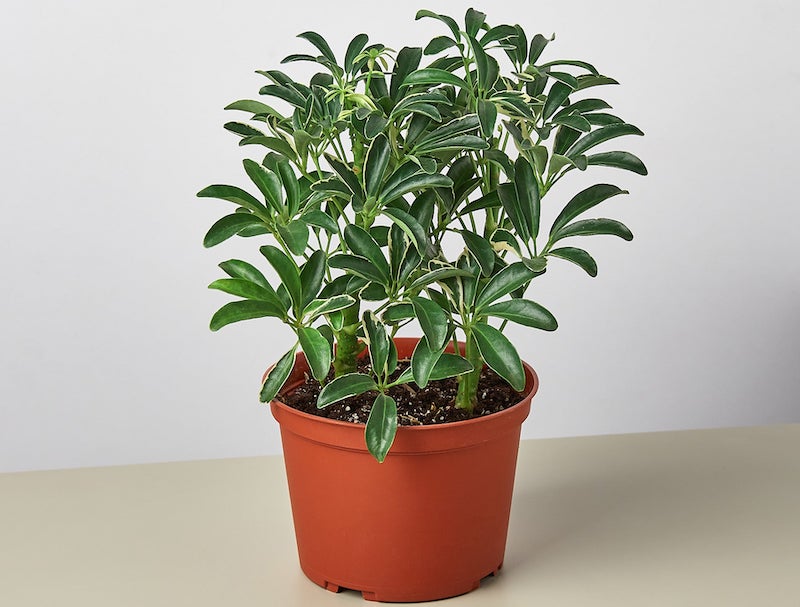Growing Schefflera
Schefflera, also known as Umbrella Plant, is a tropical plant that is easy to grow and has a unique look. Green, oblong, glossy leaves, known as leaflets, grow on the end of stems in a symmetrical pattern that resembles an umbrella. Schefflera plants can bloom, although houseplants do not typically set flowers and are grown more for their foliage. This is a slow-growing plant that provides consistent greenery and requires minimal care. Schefflera is a good fit for both beginners and expert plant owners.

Schefflera Sunlight Requirements
Place potted Schefflera plants in bright indirect light. Rotate the container, so each side receives even light. Even light ensures the plant will grow upright and have a balanced look. Plants grown in low light levels may become leggy or have extended stems. Avoid placing the plant in direct light, which can burn the glossy leaves.
Planting Schefflera
Plant Schefflera in rich, well-drained soil. The soil should be moderately moist and have a slightly acidic pH. This plant does not like wet feet, so loose soil that allows excess water to pass through is vital. Use a standard potting mix with perlite or sand mixed in to encourage drainage. Repot Schefflera once per year or when needed. You will know when the plant needs to be repotted when the roots emerge through the holes in the pot. Select a container 1 - 2 inches larger, and when possible, repot in the spring at the start of the growing season.

Watering Schefflera
Let the soil completely dry out before watering Schefflera. This plant likes to dry out in between waterings, so feel the soil or use a moisture meter to determine when it is time to water. Saturate the soil when the top layer feels dry. Drench the soil until excess water drains through the container. Schefflera plants are semi-dormant during the winter and do not require as much water. Continue monitoring the soil, and water when it is dry, usually every few weeks during the fall and winter. Schefflera prefers high humidity levels, so place the plant in a naturally humid area or use a pebble tray or humidifier to increase the moisture in the air.
Fertilizing Schefflera
Scheffleras in nature receive nutrients from plant debris, but houseplants do not have that advantage, so they need help. Schefflera are heavy feeders and do well with routine fertilization. Feeding the plant allows it to push out new growth. Use a balanced fertilizer formulated for houseplants to feed Schefflera. Apply a water-soluble fertilizer every couple of weeks throughout the growing season or use a slow-release plant food in the spring and again halfway through the growing season. Hold off on fertilizing Schefflera during the fall and winter when the plant is resting.
Common Schefflera Problems
The leaves of the Schefflera will turn yellow and fall off the stems when the plant is overwatered. Make sure the soil and container drain well, and wait until the soil is completely dry before giving the plant a drink. Over time, the roots can recover and the plant will put out new healthy growth. Plants grown in low light can become leggy and may require a trim to become more full and bushy. Trim straggly sections of stems in the spring at the start of the growing season.
Propagating Schefflera
Schefflera is easy to propagate by cuttings. Sanitize a pair of shears and cut a stem section with multiple leaves. Dip the cut end of the stem in rooting hormone and plant it a few inches deep in moist soil. Keep the soil damp and gently tug on the plant after a few weeks. If you are met with resistance, you know the cutting has set roots. Scale back on watering after the plant has set roots.

Growing Schefflera Outdoors
Green up an outdoor space by moving a potted Schefflera plant outside during the spring and summer. This tropical plant likes warm weather, so wait until there is no longer a chance of frost before moving the plant outside. Water the plant when the top two inches of soil dry out, and monitor the soil to avoid overwatering since the plant will receive water via rain and dew. Place potted Schefflera plants in a sunny spot, but avoid direct sunlight, which can damage the foliage. Hardy varieties of Schefflera, such as Winged Phoenix, can survive the winters in zone 7 and above. These varieties can add a tropical feel to outdoor landscapes and are low maintenance once established.
 |
Author Alison Cotsonas - Published 03-09-2023 |
